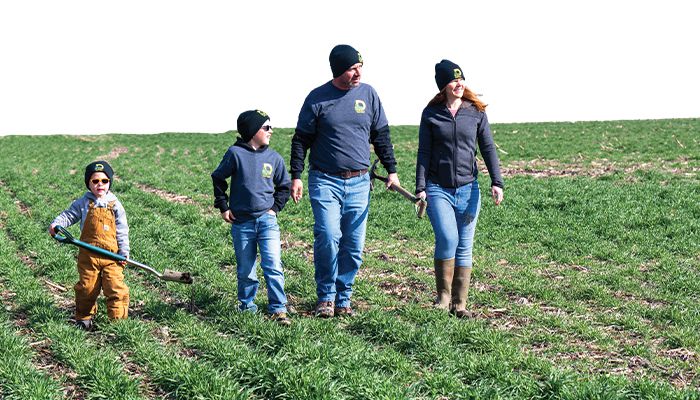Conservation counts
Author
Published
7/9/2024
Iowa farmers are leading the nation in conservation and restored wetlands.
Jackson Drost considers the long-term implacts with every decision he makes on his Mahaska County farm, especially when it comes to conservation practices.
“We have to be sustainable for years to come,” says Drost, who farms with his dad and uncle. “I want it to be there for my sons if they choose to farm.”
Drost and his wife, Amanda, have two sons, 9-year-old Richard and 3-year-old Andy, who are by their parents’ side on the farm at every opportunity. The family raises corn, soybeans and alfalfa along with an Angus cow herd.
Drost seeds cover crops on about two-thirds of his acres and also implements other conservation practices including grass waterways and terraces to keep soil in place on his southeast Iowa farm.
A growing legion of Iowa farmers are joining Drost in planting cover crops, which keep the soil covered between growing seasons to reduce erosion and protect water quality. Iowa State University research shows that cover crops can reduce nitrogen and phosphorus loss by up to 30%.
Cover crop adoption by Iowa farmers soared from 1.6 million acres in 2017 to more than 3.8 million acres in 2022, according to a survey by the Iowa Nutrient Research and Education Council (INREC), which tracks ag retailer sales data. More cover crops are grown in Iowa than any other state except Texas, according to the latest U.S. Census of Agriculture.
It's one of the many positive indicators of the conservation progress made by the state’s farmers, said Iowa Secretary of Agriculture Mike Naig. Just 15 years ago, fewer than 10,000 cover crop acres were planted in Iowa.
PICTURED ABOVE: Drost family on their Mahaska County farm. PHOTO BY CONRAD SCHMIDT
“Iowa cover crop planting has skyrocketed over the first decade of the Iowa Nutrient Reduction Strategy, and that clearly demonstrates that Iowa farmers and landowners are taking on the challenge of improving Iowa’s water quality by accelerating this important conservation work,” said Naig. “With the help of ag retailers and other conservation professionals, as well as both public and private sector partners, programs and incentives, I know our farmers and landowners will continue to push these statewide cover crop numbers ever higher.”
Cover crops are just one tool that Iowa’s farmers are using to achieve conservation progress.
Iowa farmers lead the nation in conservation tillage, which leaves more residue on the ground to reduce soil erosion and filter nutrients from runoff before it enters Iowa watersheds. According to the U.S. Census of Agriculture, more than 78% of Iowa crop acres use conservation tillage and no-till.
Iowa also ranks number one nationally in numerous other conservation practices, including continuous CRP, buffers, waterways, filter strips, water quality wetlands and pollinator habitat.
Additionally, according to a statewide conservation mapping project, Iowa farmers have installed more than 500,000 terraces stretching over 85,000 miles, a distance that would circle the Earth nearly 3.5 times.
Iowa farmers also lead the nation in the construction of water quality wetlands, which are strategically positioned to capture water and filter nitrates from field runoff. Studies show wetlands reduce nitrogen losses by 52% while also enhancing wildlife habitat.
Dedicated funding for water quality projects has helped accelerate conservation efforts in Iowa through the state’s innovative “batch and build” model, Naig reports. Batch and build modernizes conservation project management by installing wetlands and other edge-of-field water quality practices on multiple farms at the same time rather than individually.
“Before we had long-term dedicated funding for water quality efforts, we could construct 3-5 wetlands per year. Now, we are on our way toward constructing 30 per year,” Naig said. “Iowa has set conservation adoption and investment records each of the last two years, and we want to keep breaking these records year after year.”
To learn more about how Iowa farmers are continuously working to adopt conservation practices and improve water quality, visit ConservationCountsIowa.com.
Want more news on this topic? Farm Bureau members may subscribe for a free email news service, featuring the farm and rural topics that interest them most!